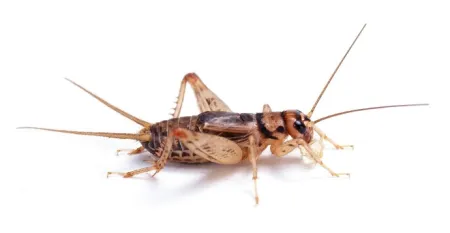About Crickets
Crickets are small insects known for the distinctive chirping sounds they make, especially at night. They’re often found in warm, damp environments and can sometimes make their way into homes. While most crickets are harmless, they can be a nuisance due to the noise they create and their habit of chewing on fabrics, paper, and plants. Understanding these common insects can help you identify them and take steps to manage them if needed.
What Do Crickets Look Like?
Crickets have a fairly recognizable appearance with long antennae, strong hind legs, and a cylindrical body. Their coloring varies depending on the species, but most are brown, black, or green.

Key features of crickets include:
- Long antennae that are often longer than their body.
- Powerful hind legs adapted for jumping.
- Cylindrical body shape with a hard exoskeleton.
- Wings on many species, with males using them to chirp.
- Size generally ranges from 1/2 inch to 2 inches, depending on the type.
What Are The Unique Characteristics of Crickets?
Crickets are more than just noisy nighttime insects. They are highly adaptable and have some unique behaviors that set them apart from other common insects.
Notable characteristics include:
- Chirping sounds produced by rubbing their wings together, primarily by males to attract mates.
- Nocturnal activity, making them more active at night.
- Strong jumping ability thanks to their large hind legs.
- Antennae used for sensing their environment, which are highly sensitive to touch and vibrations.
- Ability to survive in varied environments, from outdoors in gardens to indoor spaces.
What Do Crickets Eat?
Crickets are omnivores, feeding on both plant and animal matter. Their diet can vary depending on what’s available in their environment, which makes them highly adaptable.
Typical foods include:
- Grasses, leaves, and plant material.
- Fruits and vegetables, especially fallen or decaying produce.
- Other insects or insect eggs when available.
- Paper, fabrics, and other organic materials, particularly indoors.
This varied diet is why crickets can sometimes damage gardens or household items if populations grow unchecked.
What Are the Risks of Having a Cricket Infestation?
A cricket infestation can be more than just a minor annoyance. Large numbers of crickets can create constant chirping that disrupts sleep and quiet spaces. Indoors, they may chew on fabrics, paper, and stored food, leading to property damage. Outdoors, they can damage seedlings, garden plants, and flowers. While they don’t pose significant health risks, their presence in high numbers can indicate other pest problems and may create frustration for homeowners trying to maintain their property.
Need professional pest control services? Contact us today!